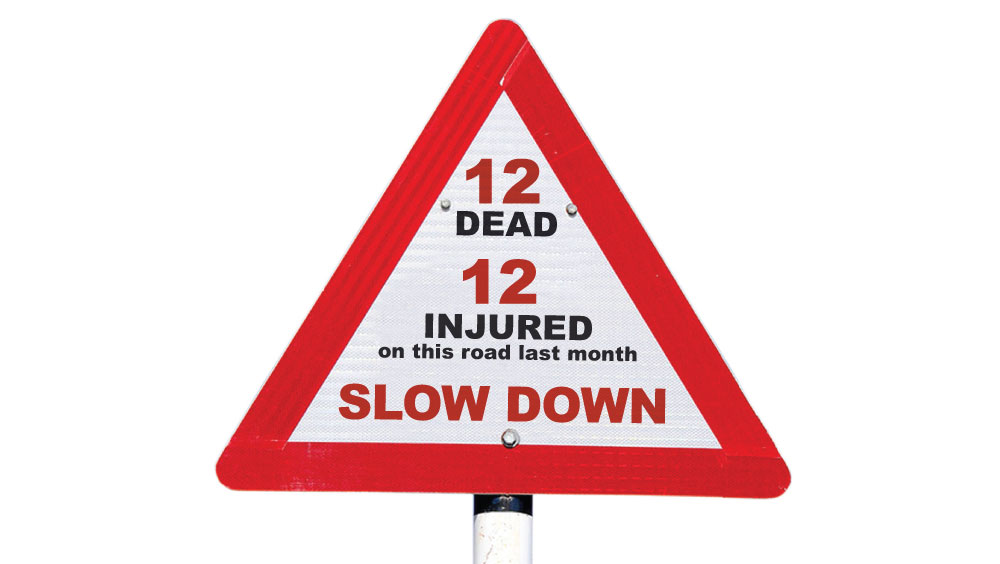
Muscat: Road signs displaying a running death toll at accident blackspots should be considered in Oman, according to road safety campaigners.
Eight people died after an accident on the road to Salalah on Sunday, bringing the total death toll on the road to 12 in the last 19 days. Another 12 people were injured over the same short period.
Read here: Death toll rises to three in Oman road crash, 12 injured
Campaigners say tired and speeding drivers need to be shocked into slowing down with a more aggressive approach to safety.
The road signs, popular in road safety campaigns around the world, chart the death toll over a given period on any dangerous stretch of road, with an appeal to drivers to take a break.
Also read: Safety checkpoints set up on danger road in Oman
The latest accident, at 11:30pm on Sunday, left eight dead – five of them Omani citizens, after two cars collided.
Many of the accidents take place inside a triangle of towns in Oman on the road to Salalah, known as Qarn al Alam Triangle.
Now road safety bosses want to erect warning triangles along the route to state the number of dead in recent accidents – in a bid to force drivers to be more cautious.
**media[706966]**
“On the 30th at 11:30pm a two vehicle crash stole eight lives near Qatbeet, Salalah,” reported the Royal Oman Police.
Just a few days earlier, three GCC tourists were killed and 12 more people were injured, “when a three car crash caused two vehicles to burst into flames,” emergency services reported. Among the dead were a mother and her child. This was in Qarn al Alam.
An Emerati national also lost his life near Salalah on the 12th.
Get your essential daily briefing delivered direct to your email inbox with our e-newsletter
Oman’s government recently reported a substantial decrease in the number of road accidents in the Sultanate for the first half of 2017, citing an 18 per cent drop. The number of deaths also declined by 6.5 per cent,
The National Centre for Statistics and Information reported that there were 314 fatalities in the first half of 2017 alone, not counting deaths in July. Campaigners say that while accidents are decreasing, blackspots are continuing to claim many lives.
Ali Al Barwani, CEO of Oman Road Safety Association said, “These days, you see cameras and radar detectors for speeding everywhere, but maybe we should have some road signs to make people aware of the deaths that happened on the road, or to tell them about the dangers of specific accidents. That is a big part of what needs to be done to revise road safety awareness in Oman.
“To have so many deaths in the last month is very, very sad. To have eight people dead in one accident alone is not a small matter.”
“Twelve people died in car accidents on the road between Dakhiliya and Salalah. 12 more were injured. Of these, almost half were non-Omanis.
“There needs to be a serious, serious rethinking, because sharing the statistics of accidents alone does not seem to do enough,” added Al Barwani.
“We must ensure that activities and regulations are properly followed. Whether it is a seat belt awareness campaign, or a child seat campaign, or one for speeding, it is important to make sure that these practices are followed.”
Many of the accidents occur in Qarn al Alam triangle, which belongs to Wilayat Adam. The Wali of Adam, HE Sheikh Hamad Rashed Hamdan al Muqbali, said: “The road is clear and well maintained. Most of these accidents happen because someone is driving long distances. The last accident happened at 11:30 p.m.
“When it’s that late or you have already driven a long stretch, you should always take a rest. You don’t have to rest in Adam, we don’t mind. Take a rest near Salalah, or close to Nizwa. It might become worse if you’re a non-Omani, because you might need to drive all the way to another country.”
The owner of a rest stop in Adam said, “My rest stop used to house more people. Nowadays, with how much faster people can get to their destination, the number has gone down. We’re still fine, praise God for everything, but it’s different.
“It affects you more if you own older establishments like mine, close to roads that tourists don’t use much anymore. They just pass us by and keep on driving without taking a rest.”
Much of Oman’s tourism occurs during the rainy seasons, said Wali Al Maqbali of Adam.
“You have to be on your guard when there’s a storm, or even a dust cloud. Unfortunately, I don’t think children under 30 understand this. It’s all about reaching the destination as quickly as possible. And then they never get there.”
Captain Muhammed Al Hasshami of ROP said: “People driving long distances, stop and take breaks, keep eyes on the road, and never overtake another vehicle unless certain that the way is clear.”